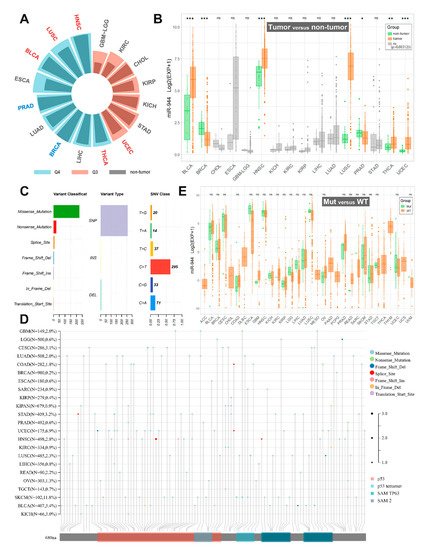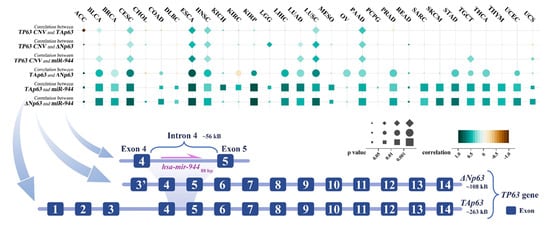miR-944 is localized in intron 4 of TP63. ΔNp63 in intron 3 of TP63 recruits the transcription factor AP-2 to promote miR-944 gene expression, which mediates epidermal differentiation induction by ΔNp63. miR-944 is dysregulated in various cancers. In squamous cell carcinoma. miR-944 can target and inhibit 27 protein-coding genes, thereby regulating cell cycle, proliferation, apoptosis, epithelial mesenchymal transition, cancer cell invasion and migration, and other cell behaviors. The genes targeted by miR-944 are involved in three signaling pathways, including the Wnt/β-catenin pathway, Jak/STAT3 pathway, and PI3K/AKT pathway. miR-944 was regulated by a total of 11 competing endogenous RNAs, including 6 circular RNAs and 5 long non-coding RNAs. Abnormally expressed miR-944 can act as an independent prognostic factor and is closely related to tumor invasion, lymph node metastasis, TNM staging, and drug resistance. miR-944 is expected to become a critical biomarker with great clinical application value in cancer.
1. Introduction
microRNAs (miRNAs) are endogenous short non-coding RNAs of approximately 22 nt that typically target the 3’ untranslated region (3’-UTR) of mRNAs
[1], thereby inhibiting the function of protein-coding genes
[2]. Dysregulation of miRNAs is often associated with the malignant transformation of cells, thereby participating in biological processes that promote cancer progression, metastasis, and treatment resistance
[3][4][3,4].
miR-944 is located in the fourth intron of tumor protein p63 (TP63) in the chromosome 3q28 region
[5] and produced at the 3’ end of the stem-loop structure of pre-mir-944. miR-944 is aberrantly expressed in more than 10 cancers. Targeted inhibition of mRNA by miRNA can be hindered by competing endogenous RNAs (ceRNAs), such as circular RNAs (circRNAs) and long non-coding RNAs (lncRNAs)
[6]. miR-944 is regulated by eleven ceRNAs, including six circRNAs and five lncRNAs. miR-944 can target and suppress 27 protein-coding genes, thereby regulating cancer cell behaviors such as cancer cell cycle, growth, proliferation, epithelial-mesenchymal transition (EMT), cancer cell invasion, and metastasis. The genes targeted by miR-944 are involved in three signaling pathways, including the Wnt/β-catenin pathway, the Jak/STAT3 pathway, and the PI3K/AKT pathway.
In patients with nasopharyngeal carcinoma (NPC)
[7], colorectal cancer (CRC)
[8][9][8,9], or breast cancer (BrC)
[10], low expression of miR-944 was not only associated with poorer overall survival (OS) but also with more advanced tumor infiltration, more lymph node metastasis, and more advanced tumor node metastasis (TNM) stage
[9]. miR-944 is associated with resistance to four anticancer drugs, including cisplatin (DDP)
[11], rapamycin (RAPA)
[12], doxorubicin (DOX)
[13], and paclitaxel (PTX)
[14]. miR-944 is involved in the molecular mechanism of action of two anticancer drugs, including the quinazolidine alkaloid matrine
[15] and a drug under clinical trials, 188Re-liposome
[16].
2. miR-944 and Its Host Gene TP63
The p63 transcription factor encoded by TP63, the host gene of miR-944, is a tumor suppressor gene belonging to the p53 family
[17]. N-terminal truncated isoform of p63 (ΔNp63), which is transcribed from an alternative promoter in intron 3 of TP63, can regulate the epithelial properties of cells and play an important role in the terminal differentiation and stemness maintenance of basal epidermal cells
[18]. miR-944 was significantly positively correlated with ΔNp63 expression in cervical cancer (CxCa) and jointly exerted a cancer-promoting effect
[19]. During the differentiation of human epidermal keratinocytes, ΔNp63 can recruit the transcription factor AP-2 to the promoter region of the miR-944 gene, thereby promoting the expression of miR-944 and inducing epidermal differentiation
[17].
3. Aberrant Expression of miR-944 in Cancer
As shown in
Table 1, miR-944 is downregulated in cells and tissues of 11 cancers. Meanwhile, miR-944 is lowly expressed in the plasma of esophageal cancer (ECa)
[20]. It is worth noting that miR-944 is highly expressed in cancer tissues of LUSC
[21] and endometrial carcinoma (EC)
[22], as well as CxCa cell lines, serum, and tissues
[5][23][24][25][5,23,24,25]. Furthermore, the expression of miR-944 in BrC is controversial. Specifically, miR-944 was highly expressed in serum and tissues of BrC
[26], whereas miR-944 was found to be downregulated in five BrC cell lines and tissues
[27].
Table 1.
Aberrant expression of miR-944 in different cancers.


